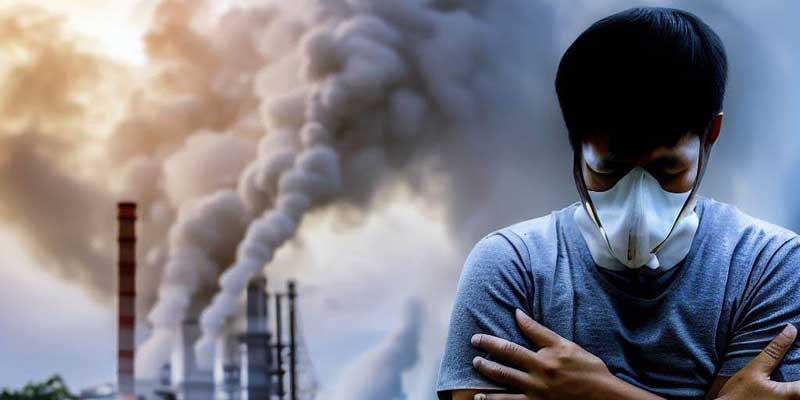Air pollution is one of the most serious environmental problems that affects millions of people around the world. It is the presence of harmful substances in the air that can cause damage to human health and the environment. Air pollution can come from various sources, such as vehicles, factories, power plants, fires, volcanoes, and dust storms. Some of the common air pollutants are particulate matter (PM), ozone (O3), nitrogen oxides (NOx), sulfur dioxide (SO2), carbon monoxide (CO), and lead (Pb).
Air pollution has both short-term and long-term effects on human health and the environment.
Some of the health effects of air pollution are:
- Respiratory diseases: Air pollution can irritate the lungs and cause inflammation, coughing, wheezing, shortness of breath, asthma attacks, bronchitis, pneumonia, and chronic obstructive pulmonary disease (COPD). Air pollution can also increase the risk of lung cancer and tuberculosis. According to the World Health Organization (WHO), air pollution is responsible for about 7 million premature deaths every year, mostly due to respiratory diseases.
- Cardiovascular diseases: Air pollution can affect the heart and blood vessels and cause high blood pressure, heart attacks, strokes, arrhythmias, and heart failure. Air pollution can also increase the levels of cholesterol and inflammation in the blood, which can lead to atherosclerosis and blood clots. A study by the American Heart Association found that long-term exposure to PM2.5 (fine particles with a diameter of 2.5 micrometers or less) increased the risk of cardiovascular mortality by 12%².
- Nervous system diseases: Air pollution can affect the brain and nervous system and cause headaches, dizziness, fatigue, stress, anxiety, depression, cognitive impairment, learning disabilities, attention deficit hyperactivity disorder (ADHD), autism spectrum disorder (ASD), Alzheimer’s disease, Parkinson’s disease, and multiple sclerosis. Air pollution can also damage the developing nervous system of fetuses and children and cause low birth weight, preterm birth, reduced IQ, behavioral problems, and neurodevelopmental disorders. A study by Harvard University found that exposure to PM2.5 during pregnancy was associated with a 3-point reduction in IQ scores of children at age 10³.
- Cancer: Air pollution can contain carcinogenic substances that can damage the DNA and cause mutations that lead to cancer. Some of the cancers that have been linked to air pollution are lung cancer, bladder cancer, breast cancer, leukemia, lymphoma, and skin cancer. The International Agency for Research on Cancer (IARC) classified outdoor air pollution as a Group 1 carcinogen in 2013⁴.
Some of the environmental effects of air pollution are:
- Climate change: Air pollution can contribute to climate change by increasing the concentration of greenhouse gases in the atmosphere, such as carbon dioxide (CO2), methane (CH4), nitrous oxide (N2O), and ozone (O3). These gases trap heat and raise the global temperature, causing changes in weather patterns, sea level rise, melting of ice caps and glaciers, extreme weather events, droughts, floods, wildfires, desertification, and biodiversity loss. According to the IPCC (Intergovernmental Panel on Climate Change), human activities have caused about 1.1°C of global warming since pre-industrial times.
- Acid rain: Air pollution can cause acid rain by combining with water vapor in the atmosphere and forming acidic compounds such as sulfuric acid (H2SO4) and nitric acid (HNO3). Acid rain can fall as rain, snow, fog, or dry deposition. Acid rain can damage buildings, monuments, statues, bridges, and other structures made of metal or stone. Acid rain can also harm plants, animals, soil, water bodies, and aquatic life by lowering the pH level and leaching nutrients and minerals.
- Smog: Air pollution can cause smog by forming a thick layer of haze in the lower atmosphere that reduces visibility and blocks sunlight. Smog is mainly composed of ozone (O3), which is formed by the reaction of NOx and volatile organic compounds (VOCs) in the presence of sunlight. Smog can worsen the health effects of air pollution by increasing respiratory and cardiovascular symptoms. Smog can also affect agriculture by reducing crop yields and quality.
- Eutrophication: Air pollution can cause eutrophication by depositing excess nutrients such as nitrogen (N) and phosphorus (P) into water bodies such as lakes, rivers, and oceans. Eutrophication can also produce toxins that can harm fish, birds, and humans.
Air pollution is a global challenge that requires collective action. By doing our part, we can reduce our emissions and improve our air quality.
Some of the actions that we can take are:
- Use public transportation, carpool, bike, or walk instead of driving
- Choose energy-efficient appliances, lighting, and heating and cooling systems
- Switch to renewable sources of energy such as solar, wind, or hydro
- Plant trees and plants that can absorb CO2 and produce oxygen
- Avoid burning wood, coal, or trash
- Recycle and reuse materials and products
- Support policies and regulations that limit air pollution and greenhouse gas emissions
- Educate ourselves and others about the causes and effects of air pollution
By doing these actions, we can protect our health and the environment from the harmful effects of air pollution. Thank you for reading this blog post and for caring about our planet.








